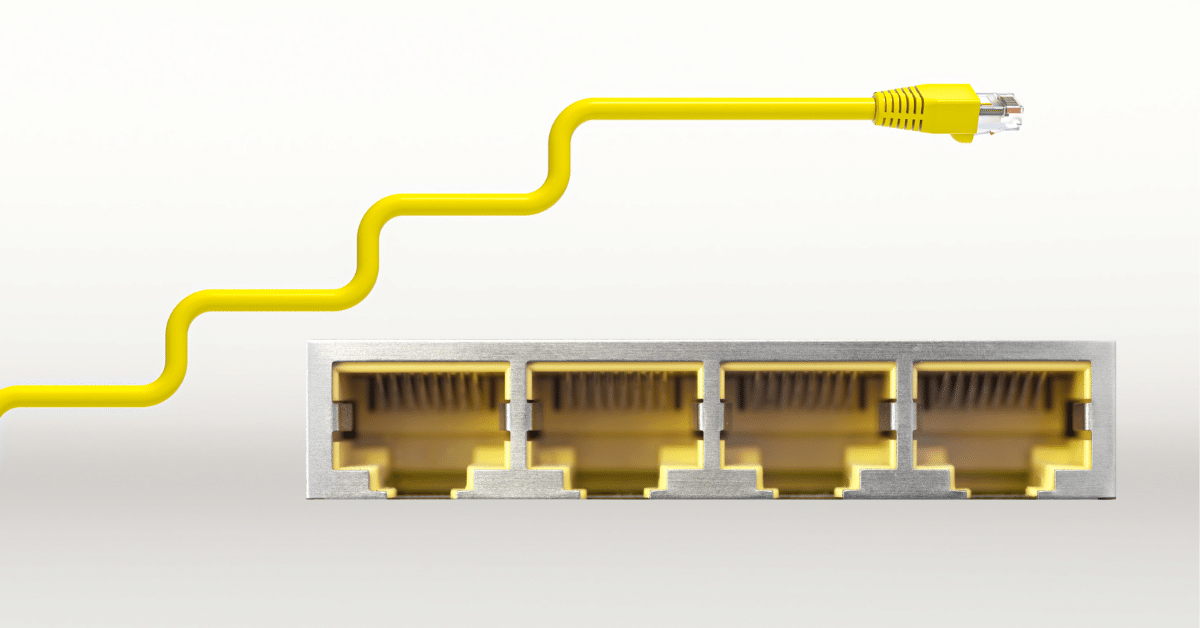If you’re looking for the perfect way to make your network faster and more reliable, then you’ve come to the right place! The best Ethernet splitter will give you maximum connection speed and reliability – so why not split your way to success? Read on to find out which splitter is right for you.
Ethernet splitters are devices used to join multiple Ethernet cables together. They enable network professionals to set up multiple computers, networks, and devices on the same cable. In essence, an Ethernet splitter is a small electrical device that helps network administrators share a single port in order to connect devices like computers or other hardware and maintain effective communication between them.
Splitters can be used for connecting additional ports for an existing device or for sharing the same port across multiple devices. Additionally, they are important to ensure greater speed and expanded access over a single connection while avoiding unnecessary struggles such as poor performance or latency issues. Ethernet splitters also save on time, money and cable length in certain applications where multiple connections are necessary but having physical ports aren’t cost effective.
Using an Ethernet splitter is the best way to help save time by using one single socket both for incoming and outgoing audio/video signals through multiple computers at once without having to install physical Ethernet ports at all locations that need access to your network.
Top 10 Best Ethernet Splitters in [wpdts-year]
Benefits of Using an Ethernet Splitter
In a network environment, using an Ethernet splitter or cable splitter to split a single Ethernet connection into two separate cables can come in handy. With the use of this device, you can save money as it eliminates the need for purchasing additional expensive components and help your work with higher efficiency.
An Ethernet Splitter enables two or more devices to share one connection point, allowing multiple computers or other compatible devices to access the Internet while sharing an existing single RJ45 port. By connecting multiple Ethernet cables (usually up to four), it allows you to connect up to four computers together into one common network cable. Using an Ethernet splitter provides several benefits such as cost savings, time savings, higher efficiency, enhanced security and usage flexibility.
Cost Savings: An important advantage of using an Ethernet splitter is that it will reduce your expenses by avoiding purchases of additional networking hardware such as modems or routers that often come with high prices.
Time Savings: Using an Ethernet splitter also helps save time in configuring your network since you won’t need to spend extra time setting up a separate router or modem for devices that could be connected with just one cable using the Ethernet splitter.
Higher Efficiency: By adding the extra ports from the splitter, you can distribute data from one source location at faster rates across multiple points without losing any speed. This will ultimately result in increased performance and reliability of all devices connected on the same LAN line or network segment.
Enhanced Security: Along with allowing faster networking speeds when adding multiple connections, using an ethernet cable splitter also improves overall security by eliminating any potential risks associated with physical hardware tampering when connecting new hardware on various networks where data transmission is essential for productivity and success.
Usage Flexibility: Another strong benefit of using an ethernet splitter is that it’s very versatile in nature hence providing more flexibility while utilizing its features and capabilities making it perfect for businesses of all sizes operating across multiple networks & locations simultaneously while keeping costs low & performance high at every step along the way..
Types of Ethernet Splitters
Ethernet splitters are devices used to connect multiple computers to a router or switch. They are also known as Ethernet ports expanders or as multiport adapters. As networking technology has evolved, different types of Ethernet splitters have been introduced that vary in terms of the number of ports, connection speed and other features. Here’s an overview of some common types of Ethernet splitters for home and business use.
Basic Splitter: This type is perfect for home networks because it splits the signal from one Ethernet port into two separate ports on the same device. It is often referred to as a “Y cable” because it usually looks like two cables connected in the middle with a third cable branching off at a right angle (though this isn’t always the case). This allows up to two computers to be connected via Ethernet rather than using separate cables for each computer like you would with standard routers.
Gigabit Splitter: This type of splitter offers users higher bandwidth and faster speeds than basic splitters by utilizing gigabit technology, which allows you to transfer data more quickly and efficiently between your router and your devices. Gigabit Ethernet splitters usually come in units that offer five, eight or even 16 ports on a single device, allowing you to easily connect many computers or other network devices at once – great for larger office environments where multiple employees need access to the Internet simultaneously.
Wireless Splitter: Another popular option is the wireless splitter which allows for sharing Wi-Fi signals among multiple devices. Wireless splitters are designed with an antenna that picks up incoming signals from your router and splits them into multiple outgoing signals so that each device can connect wirelessly without extra hardware such as individual cable lines or extra routers/switches needed – convenient if you want to create an extended wireless network outdoors without having to lay down additional cables!
How to Choose the Best Ethernet Splitter
When shopping for an Ethernet splitter, there are a few things to consider, including your network requirements, the number of ports you need, and the operating temperature range. Understanding these factors will help you choose an Ethernet splitter that works best for your needs.
Network Requirements: Before making a purchase, it’s important to consider the type of connections that you currently have or plan to have in the future. An Ethernet splitter must have a compatible port type with any device that is trying to connect to the network. Common ports include Micro-USB, RJ-45 (100BASE-T) and RJ-11 (HomePNA).
Number of Ports: Depending on the application and intended usage of an ethernet splitter, it may have more than one port connected. For example, if you need to connect multiple devices at once or share files between computers on a network then you may need an ethernet splitter with more than one port. Most ethernet splitters come with two to four ports although some splitters may have up to 16 ports.
Operating Temperature Range: The operating temperature range is also important when selecting an ethernet splitter as environmental conditions can impact performance depending on where they are used. This means ensuring that your splitter can work in temperatures ranging from 0°C/32°F up to 300°C/572°F.
By considering all of these factors when shopping for an Ethernet splitter it will be easier for you to make the right decision based on your specific needs and ensure years of reliable performance from your chosen product.
Setting up an Ethernet Splitter
When setting up an Ethernet splitter, it is important to ensure that all the necessary pieces are connected properly and in the right order. An Ethernet splitter, also known as a network splitter or a hub splitter, allows two or more computers to share an Ethernet connection by splitting the connection into two or more parts.
To begin with, you will need to connect the modem to your router or directly to one of your networked devices via an Ethernet cable. For example, if you are connecting two computers to each other wirelessly via Wi-Fi, you would need to connect them both via a cable first. Next, you should plug one end of the Ethernet cable into your modem and then plug the other end into your Network Splitter’s input port labeled “Internet.” Finally, you should use additional cables of appropriate lengths (no longer than 328 feet) to connect each device in your network from ports on your Network Splitter labeled “Output 1,” “Output 2,” and so on.
It is also important that you configure any firewalls or other security software prior to testing out your setup as this can help prevent unauthorized access by any external users attempting to gain access to your private network. After everything is correctly plugged in and connected, test all connections by opening up a web browser on each device and visiting a few websites — if they load correctly with no issues then all is good!
Troubleshooting Ethernet Splitter Issues
When setting up a network using Ethernet splitters, it is important to properly configure and troubleshoot the connections to ensure the best performance. Potential causes of issues include improperly wired connections, malfunctioning cables or ports, incompatible hardware, and outdated device drivers. The following steps can be taken to solve common technical difficulties when using an Ethernet splitter:
1. Verify that all of the cables are securely plugged in and none of the ports on the splitter are corroded or broken.
2. Check if the switch settings for data transfer speed match those of the DSL router/modem being used for connection establishment.
3. Make sure that all components including splitters, routers/modems, ethernet adapters (if applicable) are powered on and functioning normally.
4. Ensure that the router/modem firmware is up-to-date with no versions outstanding for any devices connected to it through Ethernet splitters.
5. If a firewall is installed on any device connected to an Ethernet splitter make sure that outbound connections are allowed by adjusting settings in its configuration page accordingly (or disable any existing firewalls).
6. Update any driver(s) installed on affected machine(s) found to be either out-of-date or running with outdated software versions associated with them respectively (if applicable).
7 Reset all hardware including routers/modems plus any other components (splitters etc.) once more per manufacturer specifications — along with reconfiguring necessary settings as instructed by accompanying resources where indicated so as to establish a stable internet connection via Ethernet splitters successfully once again if all else has failed thus far; there may be moments wherein certain devices may require some additional troubleshooting according to their individual needs at different times during this process — computer users should also keep in mind their Internet service provider’s recommendations when attempting such tasks too whenever possible so as not to become frustrated along the way due lack appreciation overall application requirements set forth in order for successful operation across their corresponding networks accordingly whenever feasible given respective suitable prerequisites from part(s) concerned stated previously provided within aforementioned instructions before specified herein today thoroughly altogether still carefully therefore ultimately punctually adequately reliably for viable practical honorable solution similar terms provisioned optimally therein consequentially
Frequently Asked Questions about Ethernet Splitters
If you are shopping for an Ethernet splitter, chances are you have some questions about how they work, which features to look for, and the types of connections available. We’ve answered some of the most common FAQs below to help make your purchasing decision easier.
Q: What is an Ethernet splitter?
A: An Ethernet splitter is a device that allows two or more network devices to share a single Ethernet port on a router or other broadcast device. It divides one physical Ethernet port into two or four ports and can also be used to extend the range of existing networks.
Q: How does an Ethernet splitter work?
A: An Ethernet splitter works by using clever engineering to route signals from one networked device to another without requiring each device to have its own dedicated line. The signals are split at each output port for easy connection.
Q: Do Ethernet splitters support any type of connection?
A: Yes. Most standard splitters can support Cat5, Cat 5e, and Cat 6e cables with both half-duplex and full-duplex communications protocols depending on the type of model chosen.
Q: What should I look for when buying an Ethernet splitter?
A: When choosing an Ethernet splitter, consider factors such as price, number of ports/range supported, power usage requirements/power sources available, transmission speed/compatibility with existing equipment (especially important if upgrading), durability/specifications such as safety certifications/UL listings, and any additional features that may be necessary such as LED indicators and optional reset buttons.
Conclusion
When shopping for the best Ethernet splitter, there are a few things to consider. First, you want to find one that is compatible with your network and has the bandwidth capabilities that you need. Make sure to check what kinds of cables the splitter is compatible with, too. Secondly, be sure it comes with an adapter or multiple ports depending on how many connections you need. Lastly, consider how easy it would be to set up and configure your Ethernet splitter.
Overall, an Ethernet splitter can be an incredibly useful device — enabling you to maximize your existing network connections while granting you plenty of flexibility and expandability as your needs change. While some Ethernet splitters are rather expensive and complex to configure, there are several models that offer great features at prices that won’t break the bank. After doing a bit of research and finding what works best for you — have fun and enjoy the convenience of having reliable internet access wherever you go!



